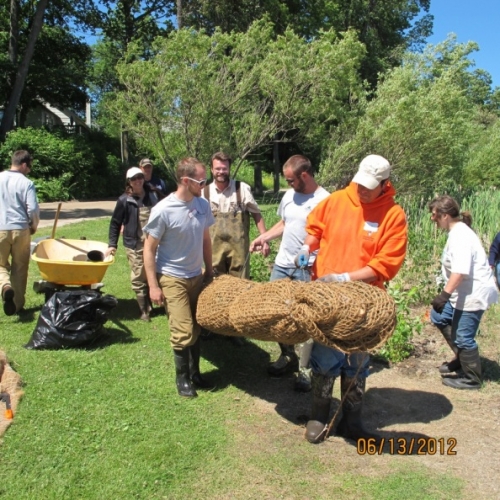Natural shoreline greeted with enthusiasm by Upper Peninsula community
Portage Township and village of Curtis host certification training at Watt-Stamper Park resulting in the construction of a natural shoreline.
 On a recent June evening,
citizens attending the regular meeting of the Portage Township board had
questions: “The Michigan
Natural Shoreline Partnership (MNSP) was in Curtis for a project at
Watt-Stamper Park?” Residents weren’t asking why, but how did MNSP come to choose Portage Township (in Mackinac County) to
host the field practicum for its flagship program entitled “Certified
Natural Shoreline Professional” (CNSP).
On a recent June evening,
citizens attending the regular meeting of the Portage Township board had
questions: “The Michigan
Natural Shoreline Partnership (MNSP) was in Curtis for a project at
Watt-Stamper Park?” Residents weren’t asking why, but how did MNSP come to choose Portage Township (in Mackinac County) to
host the field practicum for its flagship program entitled “Certified
Natural Shoreline Professional” (CNSP).
The short answer? Local government enthusiasm, cooperation and commitment. Criteria for choosing a host municipality include:
- Ownership of public park with suitable inland lake shoreline
- Interest in a natural shoreline demonstration site at that park
- Financial resources to purchase the plants and materials for such a project
- A commitment to maintaining the demonstration site, especially during the 3-5 year establishment period.
When approached about hosting a project at Watt-Stamper Park in downtown Curtis, Portage Township responded with great enthusiasm and soon committed funds to the project. Each CNSP course includes a hands-on field experience constructing a natural shoreline.
In return, the MNSP’s role, led by Jane Herbert, was to work with the township to develop a natural shoreline design that would both solve the shoreline recession problem at Watt-Stamper Park and serve the needs and goals of the township.
Through ongoing discussions, it was revealed that this shoreline, located on the north end of South Manistique Lake, experiences damage each spring due to ice piling up on the shore. This, in conjunction with the traditional management practice of mowing to the water’s edge, had resulted in shoreline recession – the root structure of turf grass is no match for the power of ice to cause damage that can result in soil erosion and shoreline recession. In addition, the township wanted to narrow snowmobile traffic and swimming access to a certain section of park shoreline.
The agreed upon design would include a six-foot wide buffer strip of densely-planted native shrubs (like Red-osier Dogwood which is better adapted to waves and ice) on each side of a designated access area. The young plants would be protected with bioengineered shoreline erosion control. The west end of the project, where the heaviest ice action occurs, would also be protected with 8-24” rock riprap.
The existing emergent aquatic plant community on the east end of the project would be supplemented with three pre-vegetated aquatic plant mats. The mats would be staked down on the lake bed and protected from waves during establishment by a brush bundle constructed on site from red pine boughs harvested locally. Since the erosion control component of the project would be located below the Ordinary High Water Mark, the township secured a Part 301 Inland Lakes and Streams permit from the Michigan Department of Environmental Quality (MDEQ).
The morning after the Portage Township meeting, CNSP participants from around the state gathered for their required certification exam at the Community Center in Curtis. They included professional landscapers, marine contractors, county soil erosion inspectors and others. All had previously completed the required three days of classroom instruction over the winter. After the exam, participants gathered at the park for their required field practicum: constructing a natural shoreline.
Instructors included Teri Grout (Alger Conservation District), Jewel Richardson (owner of Wetlands Nursery), John Skubinna (MDEQ), Dr. Robert Schutzki (MSU Department of Horticulture) and Jane Herbert (MSU Extension), all of whom are also members of the MNSP.
Hands-on construction activities included the use of plants, bioengineering materials and rock riprap to create a natural shoreline that can, when established, withstand ice action, funnel traffic to the lake, slow runoff and provide food, shade and cover for songbirds, fish, frogs and turtles. Township leaders were on-site, smiling and nodding approval as their park shoreline was planted, stabilized and transformed into a natural shoreline.
Township staff will maintain the project – keeping it weeded and watered until establishment. The demonstration site is available for use by school groups, lake associations, conservation districts and other non-profits. Interested groups should contact Portage Township at (906) 586-9522.
A CNSP program was also held in the Grand Rapids area during 2012. Participants with passing grades from both locations will join more than 100 existing Certified Natural Shoreline Professionals across Michigan. This intensive training equips contractors to expand business services at the water’s edge and prepares them to meet the requirements of changing state regulations.
For more information on the MNSP, its statewide education programs for both contractors and lakefront property owners and a list of CNSPs by county, please visit the Michigan Natural Shoreline Partnership website.
Photo: CNSP participants prepare to install a brush bundle wave break.
Photo credit: Jane Herbert



 Print
Print Email
Email


